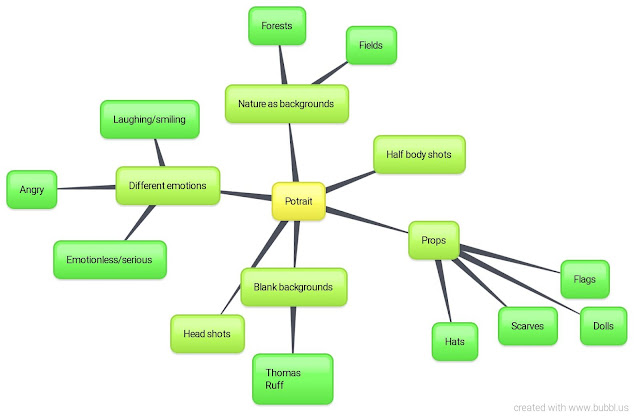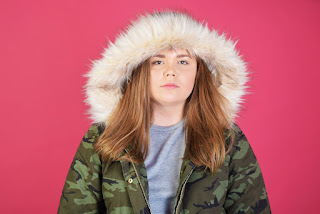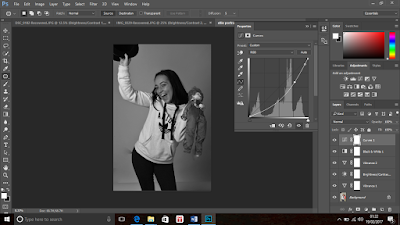Thomas Ruff is a German Photographer and one of his main focuses was Portraiture. Ruff embarked on a period of research which looked at the history of portraiture and carried out his own experiments with framing and composition. He decided on a style of portraiture which was as neutral as possible in an aim to emphasis the person's face - the individuals wore their ordinary clothes and stood against a plain background. Thomas Ruff wanted his candidates to be as emotionless as possible. He outlined that some portrait photographers aim to convey a deeper meaning within a portrait however, Ruff was convinced that a photo is only able to express the superficial, literally showing us the surface of its subject. Ruff first produced this type of work on large scale in 1986.

This is a good example of a photograph from Thomas Ruff because it is effective in presenting the key components which made up a piece of his work. The women is staring blankly into the camera and conveys no emotion. This is exactly what Thomas Ruff was aiming to achieve. Due to there being no expression on the woman's face, we cannot tell what she is thinking, feeling and so on. Ironically, I think that the approach which Ruff has taken is more interesting than other representations of portrait photography because it makes us really think hard to make something out of the picture. For example, it isn't predictable (she isn't smiling, but that doesn't necessarily mean that she is not happy). The white background makes the face of the individual stand out, which the photographer has done consciously, to highlight the emotionless expression of his candidate. We are forced to focus of the face of the individual and therefore the expression in which they hold, due to it being a head shot. I think that the photographer has outlined the fact that a picture can be taken in lots of different ways, by different individuals and therefore presented individuals in this way. By him using this approach to portrait photography, it allows us to take whatever we wish from a picture, rather than the photograph deciding how the person is feeling (by photographing someone laughing, does it actually mean that they are happy? However, we may just think that they must be happy due to them being photographed laughing).

This is another example of Ruff's work. Once again, the women remains completely emotionless, against a plain background. She is not dressed smart, but in ordinary clothes. He has tried to keep the image as natural as possible. The photographer has photographed many people, who are all individuals with different lives, however are all presented in the same way. We therefore cannot make prejudgements about them as people as they are all performing the same action. I like this image because she looks relaxed.

I like this example of his work because it shows how even though he photographed both males and females, there is no difference in the methods he used to create his work. The man is once again, emotionless, standing against a black background and wearing ordinary clothes. Experiences may vary between men and women however, they are both presented the same way so we cannot take anything in which is specific to the man as an individual or his life. The soft pastel background makes his pale face stand out and the background contrasts with his dark hair. Furthermore, we really focus on his face and the expression he is pulling. Thomas Ruff has consciously chose specific background colours (all which are neutral) which work best for a specific individual. Within each example I have shown, the background colours differ between individuals, as the photographer has picked the colours which are most effective in emphasising their faces.
I like Thomas Ruff's style of portrait photography because I find it interesting how as quoted, we can just see the surface of the subject (the persons outer layer) and that we cannot make judgements about what they are thinking or feeling because there isn't much to work with.
 This image was taken in Greece, Cyclades, Island of Sifhnos in 1961. Henri Cartier Bresson had taken this photograph while the girl was running up the stairs. Her body shape tells us that she is in the middle of running. The style of the buildings present the style of old Greece. The building are not modern or up to date (as we can tell by the arrangement of the staircase and how the door frames are not particularly straight). This image is a good representative of the decisive moment and how the photographer had to think carefully about the precise moment to take the picture. If he had taken the image a few seconds later, the girl would not be visible. This would make the image less about documentary photography and less intriguing to look at. I like this image because although we can only see a singular person in the image, there could have possibly been several others running up the stairs also. Therefore, the photographer had taken timing very seriously. In conclusion, timing is very important when documenting an event. I also like how there is a clear distinction between the light and dark tones. The child is far away and is a area of shade is casted over them which makes the outline of the body and the action they are showing more vivid.
This image was taken in Greece, Cyclades, Island of Sifhnos in 1961. Henri Cartier Bresson had taken this photograph while the girl was running up the stairs. Her body shape tells us that she is in the middle of running. The style of the buildings present the style of old Greece. The building are not modern or up to date (as we can tell by the arrangement of the staircase and how the door frames are not particularly straight). This image is a good representative of the decisive moment and how the photographer had to think carefully about the precise moment to take the picture. If he had taken the image a few seconds later, the girl would not be visible. This would make the image less about documentary photography and less intriguing to look at. I like this image because although we can only see a singular person in the image, there could have possibly been several others running up the stairs also. Therefore, the photographer had taken timing very seriously. In conclusion, timing is very important when documenting an event. I also like how there is a clear distinction between the light and dark tones. The child is far away and is a area of shade is casted over them which makes the outline of the body and the action they are showing more vivid. 

















































